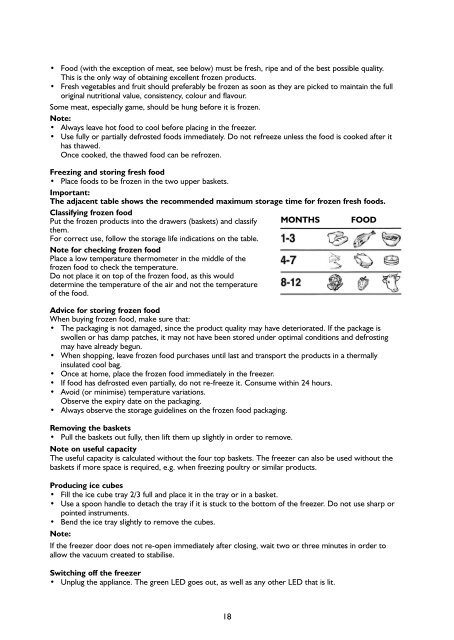KitchenAid U 12 A1 D/HA - U 12 A1 D/HA NL (F093760) Istruzioni per l'Uso
KitchenAid U 12 A1 D/HA - U 12 A1 D/HA NL (F093760) Istruzioni per l'Uso
KitchenAid U 12 A1 D/HA - U 12 A1 D/HA NL (F093760) Istruzioni per l'Uso
You also want an ePaper? Increase the reach of your titles
YUMPU automatically turns print PDFs into web optimized ePapers that Google loves.
• Food (with the exception of meat, see below) must be fresh, ripe and of the best possible quality.<br />
This is the only way of obtaining excellent frozen products.<br />
• Fresh vegetables and fruit should preferably be frozen as soon as they are picked to maintain the full<br />
original nutritional value, consistency, colour and flavour.<br />
Some meat, especially game, should be hung before it is frozen.<br />
Note:<br />
• Always leave hot food to cool before placing in the freezer.<br />
• Use fully or partially defrosted foods immediately. Do not refreeze unless the food is cooked after it<br />
has thawed.<br />
Once cooked, the thawed food can be refrozen.<br />
Freezing and storing fresh food<br />
• Place foods to be frozen in the two up<strong>per</strong> baskets.<br />
Important:<br />
The adjacent table shows the recommended maximum storage time for frozen fresh foods.<br />
Classifying frozen food<br />
Put the frozen products into the drawers (baskets) and classify<br />
them.<br />
For correct use, follow the storage life indications on the table.<br />
Note for checking frozen food<br />
Place a low tem<strong>per</strong>ature thermometer in the middle of the<br />
frozen food to check the tem<strong>per</strong>ature.<br />
Do not place it on top of the frozen food, as this would<br />
determine the tem<strong>per</strong>ature of the air and not the tem<strong>per</strong>ature<br />
of the food.<br />
MONTHS FOOD<br />
Advice for storing frozen food<br />
When buying frozen food, make sure that:<br />
• The packaging is not damaged, since the product quality may have deteriorated. If the package is<br />
swollen or has damp patches, it may not have been stored under optimal conditions and defrosting<br />
may have already begun.<br />
• When shopping, leave frozen food purchases until last and transport the products in a thermally<br />
insulated cool bag.<br />
• Once at home, place the frozen food immediately in the freezer.<br />
• If food has defrosted even partially, do not re-freeze it. Consume within 24 hours.<br />
• Avoid (or minimise) tem<strong>per</strong>ature variations.<br />
Observe the expiry date on the packaging.<br />
• Always observe the storage guidelines on the frozen food packaging.<br />
Removing the baskets<br />
• Pull the baskets out fully, then lift them up slightly in order to remove.<br />
Note on useful capacity<br />
The useful capacity is calculated without the four top baskets. The freezer can also be used without the<br />
baskets if more space is required, e.g. when freezing poultry or similar products.<br />
Producing ice cubes<br />
• Fill the ice cube tray 2/3 full and place it in the tray or in a basket.<br />
• Use a spoon handle to detach the tray if it is stuck to the bottom of the freezer. Do not use sharp or<br />
pointed instruments.<br />
• Bend the ice tray slightly to remove the cubes.<br />
Note:<br />
If the freezer door does not re-open immediately after closing, wait two or three minutes in order to<br />
allow the vacuum created to stabilise.<br />
Switching off the freezer<br />
• Unplug the appliance. The green LED goes out, as well as any other LED that is lit.<br />
18
















